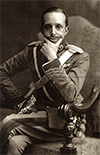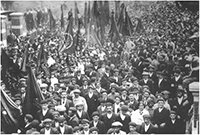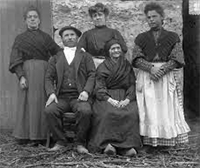The Spanish Civil War
Part 1: Conflicts Arising The Spanish Civil War raged for three years throughout the country in the late 1930s and featured aid, weapons, and manpower from foreign powers. The result was a victory for Nationalist forces and the beginning of a dictatorship. Spain in the 20th Century was not the great power that it had been in centuries past. With defeat in the Spanish-American War, in 1898, Spain lost its remaining territories in the New World and the Pacific. 
King Alfonso XIII (left) and Spain had declared neutrality during World War I. One reason was that the king had family connections on both sides. His wife's uncle was the U.K. monarch (King Edward VII), and his mother had ties to the Austrian royalty. Another reason for Spain's neutrality was that the country played no part in either of the major entangling alliances (Triple Alliance and Triple Entente) that presaged the Great War and so felt no need to go to war just because another country had been attacked. German submarines sank dozens of Spanish ships during the war, and an absence of trade with other nations significantly affected the Spanish economy. Complicating the situation were up to 10,000 workers who returned to their homes as refugees from war-torn Belgium, France, and Germany. Striking Spain and nearly every other world power after the war as well was the Spanish Flu. One of the earth-shaking events that happened during the war was the Russian Revolution, which resulted in the death of the Russian tsar and the installation of a Communist government. The ideas of Communism appealed to many people across Europe, particularly the poor and disadvantaged. Spain, like many other countries in the wake of the devastation of World War I, had a large number of people The Great Depression hit while Spain was in the midst of a dictatorship. Spain had, in 1921, declared war to hold on to the Rif region in Morocco. During that conflict, Spanish General Miguel Primo de Rivera launched a coup and declared himself a dictator. The king approved of the move, and Rivera was in charge until 1930. Public opinion of the dictatorship and the king's support for it waned, especially when Rivera proved unable to reverse the downward spiral of the national economy and mood. Alfonso XIII, too, became highly unpopular and, after a disastrous showing in the 1931 elections, agreed to leave the country, in favor of the founding of the Second Spanish Republic. The new government, wary of the still powerful army, forced military officers to retire. A backlash came in the form of a series of coups, none of which succeeded in ousting the government but all of which fostered fear and uncertainty throughout the land. In essence, the Spanish Civil War was yet another chapter in the age-old struggle between elites and commoners, monarchists and republicans, and Catholics and non-Catholics. 
The 1933 elections resulted in a victory for right-wing (conservative, monarchist) parties. The Radical Republican Party formed a government and set about reversing some of the actions taken by the previous (left-leaning) government. Protests in the streets increased, as did overall uncertainty. The two sides traded accusations. A violent clash came in 1934, as miners in Asturias rose up in protest and the government responded in force, with troops led by General Francisco Franco cracking down hard on the protesters. Franco, the onetime head of the military academy, later became army chief of staff. Next page > The War Begins > Page 1, 2, 3 |
|
Social Studies for Kids
copyright 2002–2026
David White



 who felt dispossessed–of means, of money, and of opportunity. This had long been the case, but the Great Depression exacerbated the chasm between rich and poor. Many people who felt that their government had failed them embraced the ideas of Communism.
who felt dispossessed–of means, of money, and of opportunity. This had long been the case, but the Great Depression exacerbated the chasm between rich and poor. Many people who felt that their government had failed them embraced the ideas of Communism.
